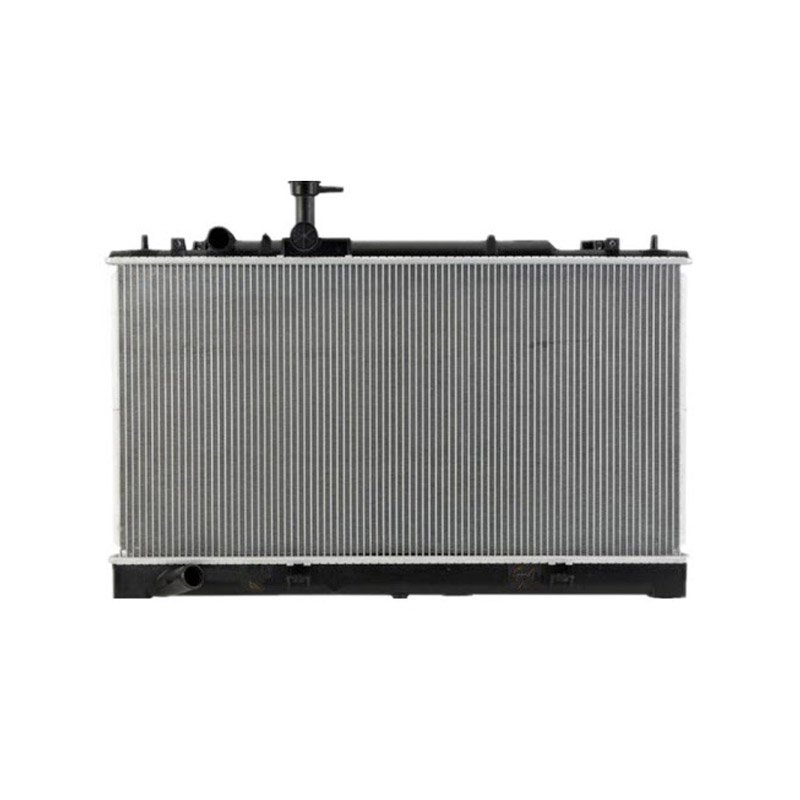What Causes Low Coolant in the Radiator Despite a Full Reservoir Tank?
May 09, 2024
Table of Contents
Unveiling the Mystery: Causes of Low Coolant in the Radiator Despite a Full Reservoir
Low coolant levels in the radiator despite a full reservoir tank can indicate several underlying issues, including:
* **Leaks:** Coolant can leak from various points in the cooling system, such as hoses, gaskets, or the radiator itself.
* **Air pockets:** Air pockets trapped in the cooling system can prevent coolant from circulating properly, leading to low levels in the radiator.
* **Overheating:** Excessive engine heat can cause coolant to evaporate or boil off, resulting in low levels.
* **Head gasket failure:** A blown head gasket can allow coolant to leak into the engine's combustion chambers, reducing the amount available in the radiator.
* **Water pump issues:** A faulty water pump may not circulate coolant effectively, leading to low levels in the radiator.

Head Gasket Failure
**What Causes Low Coolant in the Radiator Despite a Full Reservoir Tank?**
When the coolant level in the radiator drops despite a full reservoir tank, it can indicate an underlying issue. One potential cause is head gasket failure.
The head gasket is a crucial component that seals the cylinder head to the engine block. When it fails, it can allow coolant to leak into the combustion chamber or oil passages. This leakage can lead to a decrease in coolant levels in the radiator.
Symptoms of head gasket failure include:
* **Low coolant levels:** Despite filling the reservoir tank, the coolant level in the radiator continues to drop.
* **White or milky oil:** Coolant leaking into the oil can cause it to appear white or milky.
* **Overheating:** The loss of coolant can lead to overheating, as the coolant is responsible for absorbing and dissipating heat from the engine.
* **Exhaust smoke:** Coolant leaking into the combustion chamber can produce white or blue smoke from the exhaust.
* **Rough engine idle:** Air bubbles in the coolant system caused by head gasket failure can lead to rough engine idling.
Diagnosing head gasket failure can be complex and requires specialized tools and expertise. A mechanic will typically perform a series of tests, including:
* **Compression test:** This test measures the pressure in each cylinder to identify any leaks.
* **Leakdown test:** This test introduces compressed air into the cylinders to detect leaks in the head gasket.
* **Chemical test:** A chemical test can detect the presence of combustion gases in the coolant, indicating a head gasket leak.
If head gasket failure is confirmed, it is essential to repair it promptly. The repair involves removing the cylinder head, replacing the head gasket, and resurfacing the cylinder head and engine block. This is a complex and time-consuming procedure that should be performed by a qualified mechanic.
Ignoring head gasket failure can lead to severe engine damage, including overheating, seized pistons, and even catastrophic engine failure. Therefore, it is crucial to address low coolant levels in the radiator promptly and have the underlying cause diagnosed and repaired by a professional.
Faulty Radiator Cap
Despite maintaining a full reservoir tank, low coolant levels in the radiator can be a perplexing issue. Understanding the underlying causes is crucial to address this problem effectively. One potential culprit is a faulty radiator cap.
The radiator cap plays a vital role in maintaining the proper pressure within the cooling system. When the engine is running, the coolant expands, increasing the pressure in the system. The radiator cap is designed to release excess pressure through a spring-loaded valve. However, if the cap is faulty or damaged, it may not seal properly, allowing coolant to escape.
A faulty radiator cap can manifest in several ways. It may fail to maintain the necessary pressure, causing the coolant to boil at a lower temperature. This can lead to the formation of steam pockets within the cooling system, reducing its efficiency and potentially overheating the engine. Additionally, a faulty cap may allow air to enter the system, which can cause corrosion and further damage to the radiator and other components.
Diagnosing a faulty radiator cap is relatively straightforward. If the coolant level in the reservoir tank is consistently low despite being filled, and there are no visible leaks in the hoses or radiator, the cap should be inspected. A simple test involves removing the cap when the engine is cold and checking for any signs of damage or wear. If the cap appears damaged or the spring is weak, it should be replaced.
Replacing a radiator cap is a relatively inexpensive and straightforward repair. It is important to use a cap that is specifically designed for the vehicle's cooling system. After replacing the cap, the coolant level should be checked and adjusted as necessary.
In conclusion, a faulty radiator cap can be a common cause of low coolant levels in the radiator despite a full reservoir tank. By understanding the role of the radiator cap and its potential failure modes, mechanics and vehicle owners can effectively diagnose and address this issue, ensuring the proper functioning of the cooling system and preventing potential engine damage.
Leaking Radiator Hoses
Despite maintaining a full reservoir tank, low coolant levels in the radiator can be a perplexing issue. One potential culprit lies in leaking radiator hoses. These hoses, responsible for transporting coolant throughout the engine, can develop cracks or holes over time, leading to coolant loss.
Identifying a leaking radiator hose is crucial. Inspect the hoses visually for any visible damage, such as cracks, bulges, or tears. Additionally, check for any signs of coolant residue or stains around the hose connections. If you suspect a leak, apply pressure to the hose while the engine is running. If coolant seeps out, the hose is likely the source of the problem.
The consequences of a leaking radiator hose extend beyond low coolant levels. As coolant escapes, the engine's ability to regulate temperature is compromised. This can lead to overheating, which can cause severe engine damage if left unchecked. Moreover, coolant loss can result in reduced lubrication for the water pump, potentially leading to its failure.
Addressing a leaking radiator hose is essential to prevent further issues. The most effective solution is to replace the damaged hose with a new one. This involves draining the coolant, removing the old hose, and installing the new one. Ensure the hose clamps are tightened securely to prevent future leaks.
In some cases, a temporary fix may be necessary until a replacement hose can be obtained. Applying a radiator hose sealant can temporarily seal small leaks, allowing you to drive for a short period. However, it is important to note that this is not a permanent solution and should only be used as a stopgap measure.
Preventing radiator hose leaks is crucial for maintaining optimal engine performance. Regular inspections of the hoses can help identify any potential issues early on. Additionally, using high-quality hoses and replacing them as recommended by the manufacturer can extend their lifespan and reduce the risk of leaks.
In conclusion, leaking radiator hoses can be a significant cause of low coolant levels in the radiator despite a full reservoir tank. Identifying and addressing these leaks promptly is essential to prevent engine damage and ensure the proper functioning of the cooling system. Regular inspections and preventive maintenance can help minimize the risk of radiator hose leaks and maintain a healthy cooling system.
Engine becomes too hot
**What Causes Low Coolant in the Radiator Despite a Full Reservoir Tank?**
When the coolant level in the radiator drops despite a full reservoir tank, it can be a perplexing issue. Understanding the underlying causes is crucial to prevent engine damage and ensure optimal vehicle performance.
One potential cause is a leak in the cooling system. This can occur at various points, such as the radiator, hoses, or water pump. A leak allows coolant to escape, leading to a gradual decrease in the radiator's coolant level. Inspecting the system for any visible leaks is essential.
Another possibility is a faulty radiator cap. The radiator cap maintains pressure in the cooling system, preventing coolant from boiling prematurely. A damaged or loose cap can allow coolant to evaporate, resulting in a drop in the radiator's level. Replacing the radiator cap is a relatively simple and inexpensive solution.
Furthermore, a malfunctioning thermostat can contribute to low coolant levels. The thermostat regulates the flow of coolant through the engine. If it fails to open properly, coolant may not circulate adequately, causing the engine to overheat. This can lead to coolant loss through evaporation or boiling.
In some cases, a blown head gasket can also be the culprit. A head gasket seals the cylinder head to the engine block. If it fails, coolant can leak into the combustion chamber or oil passages, reducing the coolant level in the radiator. This is a serious issue that requires immediate attention.
Additionally, a cracked or warped cylinder head can cause coolant loss. This can occur due to overheating or excessive pressure in the cooling system. A cracked cylinder head allows coolant to leak into the combustion chamber or oil passages, resulting in a drop in the radiator's level.
To address low coolant levels, it is crucial to identify and repair the underlying cause promptly. This may involve replacing a leaking hose, tightening a loose radiator cap, or installing a new thermostat. In more severe cases, such as a blown head gasket or cracked cylinder head, professional repairs are necessary.
Regularly monitoring the coolant level and inspecting the cooling system for leaks can help prevent engine damage and ensure the vehicle's optimal performance. If low coolant levels persist despite a full reservoir tank, it is advisable to seek professional assistance to diagnose and resolve the issue effectively.
problem with the heater
Despite maintaining a full reservoir tank, low coolant levels in the radiator can be a perplexing issue. Understanding the underlying causes is crucial to address this problem effectively.
One potential cause is a leak in the cooling system. Inspect the hoses, gaskets, and radiator for any visible cracks or leaks. Even small leaks can gradually deplete coolant levels over time. If a leak is detected, it should be repaired promptly to prevent further coolant loss.
Another possibility is a faulty radiator cap. The radiator cap maintains pressure in the cooling system, preventing coolant from boiling over. A damaged or loose cap can allow coolant to escape, leading to low levels in the radiator. Replacing the radiator cap is a relatively simple and inexpensive solution.
A malfunctioning thermostat can also contribute to low coolant levels. The thermostat regulates the flow of coolant through the system, ensuring that the engine operates at the optimal temperature. A stuck-open thermostat can allow coolant to circulate continuously, resulting in excessive evaporation and low radiator levels. Replacing the thermostat can resolve this issue.
In some cases, low coolant levels may be caused by a blown head gasket. A head gasket seals the cylinder head to the engine block, preventing coolant and oil from mixing. A blown head gasket can allow coolant to leak into the combustion chamber, leading to low levels in the radiator. This is a more serious issue that requires professional repair.
Additionally, a faulty water pump can also cause low coolant levels. The water pump circulates coolant throughout the system, and a malfunctioning pump can reduce the flow of coolant, leading to overheating and low radiator levels. Replacing the water pump is necessary to restore proper coolant circulation.
It's important to note that low coolant levels can also be a symptom of other underlying issues, such as a cracked engine block or a faulty heater core. If the aforementioned causes have been ruled out, further diagnosis by a qualified mechanic may be necessary to identify and address the root cause of the problem.
Coolant leaking
Despite maintaining a full reservoir tank, low coolant levels in the radiator can be a perplexing issue. Understanding the underlying causes is crucial to address this problem effectively.
One potential cause is a leak in the cooling system. Inspect the hoses, clamps, and radiator for any visible cracks, tears, or loose connections. A leak can allow coolant to escape, leading to a gradual decrease in the radiator's coolant level.
Another possibility is a faulty radiator cap. The cap plays a vital role in maintaining the correct pressure within the cooling system. A damaged or loose cap can allow coolant to evaporate or leak out, resulting in low levels in the radiator.
Furthermore, a malfunctioning thermostat can contribute to low coolant levels. The thermostat regulates the flow of coolant through the system. If it fails to open properly, coolant may not circulate adequately, causing overheating and potential coolant loss.
In some cases, a blown head gasket can also lead to low coolant levels. A head gasket seals the cylinder head to the engine block. If it fails, coolant can leak into the combustion chamber or exhaust system, resulting in a decrease in the radiator's coolant level.
Additionally, a cracked or warped cylinder head can cause coolant to leak into the engine oil. This can lead to a milky appearance in the oil and a gradual loss of coolant from the radiator.
It is important to note that low coolant levels can also be caused by factors unrelated to leaks. For instance, excessive evaporation due to high engine temperatures or prolonged use can contribute to coolant loss.
To prevent low coolant levels, regular maintenance is essential. Inspect the cooling system components periodically for any signs of damage or wear. Replace the radiator cap as recommended by the manufacturer. Ensure the thermostat is functioning correctly and address any potential head gasket or cylinder head issues promptly.
By understanding the causes of low coolant levels in the radiator despite a full reservoir tank, you can effectively diagnose and resolve the issue. Regular maintenance and prompt attention to any potential problems will help maintain the integrity of your cooling system and prevent costly repairs in the future.
The engine warning light
**What Causes Low Coolant in the Radiator Despite a Full Reservoir Tank?**
When the engine warning light illuminates, indicating low coolant levels, it can be perplexing to discover a full reservoir tank. This discrepancy can stem from several underlying issues that require prompt attention.
One potential cause is a leak in the cooling system. Coolant can escape through cracks or holes in hoses, gaskets, or the radiator itself. Inspect these components thoroughly for any visible signs of damage or leaks. If a leak is detected, it must be repaired or replaced to prevent further coolant loss.
Another possibility is a faulty radiator cap. The cap maintains pressure in the cooling system, preventing coolant from boiling over. A damaged or loose cap can allow coolant to evaporate, leading to low levels in the radiator. Replacing the radiator cap is a relatively simple and inexpensive solution.
Air pockets trapped in the cooling system can also contribute to low coolant levels. Air pockets can prevent coolant from circulating properly, resulting in overheating and coolant loss. To eliminate air pockets, bleed the cooling system by opening the bleeder valve located on the radiator or engine.
In some cases, a blown head gasket can be the culprit. A head gasket seals the cylinder head to the engine block, preventing coolant and oil from mixing. A blown head gasket can allow coolant to leak into the combustion chamber, reducing coolant levels in the radiator. This issue requires immediate professional attention to prevent engine damage.
Finally, a faulty water pump can also lead to low coolant levels. The water pump circulates coolant throughout the cooling system. A malfunctioning water pump can reduce coolant flow, causing overheating and coolant loss. Replacing the water pump is necessary to restore proper coolant circulation.
If you encounter low coolant levels despite a full reservoir tank, it is crucial to identify and address the underlying cause promptly. Ignoring this issue can lead to severe engine damage and costly repairs. By following these troubleshooting steps and seeking professional assistance when necessary, you can ensure the proper functioning of your vehicle's cooling system and prevent future problems.
Broken gasket in the head
Despite maintaining a full reservoir tank, low coolant levels in the radiator can be a perplexing issue. Understanding the underlying causes is crucial for effective troubleshooting and preventing engine damage. One potential culprit is a broken gasket in the head.
The head gasket is a critical component that seals the cylinder head to the engine block. When this gasket fails, it can create a pathway for coolant to leak into the combustion chamber or exhaust system. This leakage depletes the coolant in the radiator, leading to overheating and potential engine damage.
Several factors can contribute to a broken head gasket, including:
* **Overheating:** Extreme engine temperatures can weaken the gasket material, causing it to fail.
* **Age and wear:** As engines age, the head gasket can deteriorate and become less effective at sealing.
* **Improper installation:** Incorrectly installed head gaskets can create gaps or leaks.
* **Defective gasket:** Manufacturing defects or poor-quality materials can result in a faulty gasket.
Symptoms of a broken head gasket include:
* **Low coolant levels:** Despite a full reservoir tank, the radiator coolant level drops rapidly.
* **White smoke from the exhaust:** Coolant leaking into the combustion chamber can produce white smoke.
* **Bubbles in the coolant:** Air or exhaust gases entering the cooling system can create bubbles in the coolant.
* **Overheating:** The loss of coolant reduces the engine's ability to dissipate heat, leading to overheating.
If you suspect a broken head gasket, it is essential to seek professional assistance immediately. Ignoring this issue can result in severe engine damage and costly repairs. A mechanic will diagnose the problem and determine the appropriate course of action, which may involve replacing the head gasket and other affected components.
Preventing a broken head gasket requires proper engine maintenance and avoiding overheating. Regular coolant flushes and inspections can help identify potential issues early on. Additionally, using high-quality coolant and following the manufacturer's recommended maintenance schedule can extend the life of the head gasket and the overall health of the engine.**Conclusion:**
Low coolant levels in the radiator despite a full reservoir tank can be attributed to various factors, including:
* Leaks in the cooling system, such as from hoses, gaskets, or the radiator itself
* Air pockets trapped in the cooling system
* Overheating or boiling of the coolant, causing evaporation
* Combustion gases leaking into the cooling system, indicating a blown head gasket
* Faulty radiator cap or thermostat
* Excessive coolant consumption due to engine wear or other mechanical issues





